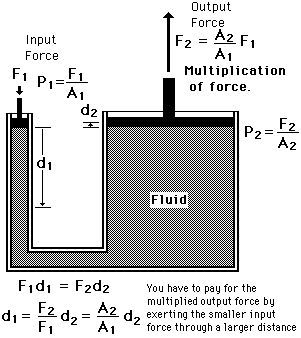In this hydraulic system, a small force, F1 is applied to the small piston resulting in a large force , F2 at the piston K. The pressure, due to the force, F1, is transmitted by the liquid to the large piston.
Pressure, P = F1/A1
This pressure is transmitted through the liquid and acts on the base of the large piston.
Force on the large piston, F2 = P X A2.
= (F1/A1) X A2.
The large force causes the load to rise.
Also F2/F1 = A2/A1
Output force / input force = output piston area / input piston area
Because of the much larger surface area, A2 of the piston K compared to the surface area, A1 of the piston, the resultant force, F1.

This shows that a large force can be produced by a small force, using Pascal's principle.
Hydraulic systems act as a force multiplier where A2/A1 is the multiplying factor.
For example, if A2=5A1, then F2 = 5F1
since F2 = F1 X (A2/A1)
A hydraulic system must not contain any air bubbles in any portion of its hydraulic fluid system.
The presence of air bubbles in the hydraulic fluid system will reduce the efficiency of the system as part of the applied force will be used to compress the air bubbles.